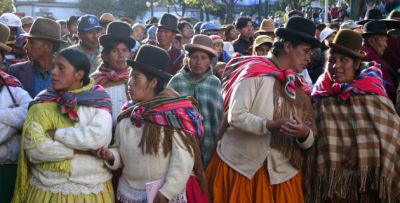
 La Paz - Take a Deep Breath
La Paz - Take a Deep Breath
Wednesday 31st October 2012 | Osh
Bolivia’s Capital City will knock you for six
Quite suddenly, you turn a bend in the road, and the city dazzles you. Buildings scale the cleavage of the city's deep canyon, spiraling down endlessly, and creeping up towards the cerulean sky like giant bronze stepping stones dripping in sunlight. The snow-topped mountains of the altiplano peek over the verge, guardians to the valley below. The scale and beauty of the highest capital city in the world, is quite literally staggering.
This panoramic view of the city is best achieved when arriving in La Paz via bus, as the route brings you through the dusty plain of El Alto, and to the rim of the canyon. A long and uncomfortable bus journey is possibly not the preferred mode of transport for many, but this view is not to be missed. Besides, for those on a budget, buses are the cheapest way to travel around this incredible country.
Bolivia’s capital is dizzying. The extreme altitude does cause some unfortunate tourists to suffer from altitude sickness. The symptoms are affected by how quickly you reach the high altitude, so it is often recommended that travelers make their way skyward in stages. If you are planning to tour Bolivia, consider starting your trip at regions with lower altitudes, and traveling towards the highlands (another reason to skimp on buses and travel overland rather than flying directly to La Paz from sea level).
For most, however, the altitude will do nothing more than make you a little out of breath and slightly wobbly on your legs. You will notice very quickly that everyone walks very slowly in La Paz, and for good reason. Keep to the pace of the locals and try to follow their famous saying "Camina lentito, come poquito ... y duerme solito" ("Walk slowly, eat only a little bit ... and sleep by your poor little self"). As you can imagine, not many backpackers adhere to the second warning (the salteñas - meat filled pastries, are far too tempting) , and even less to the third.
The best time to visit La Paz is during it’s winter months of June and July- the temperatures are slightly cooler, but these are the driest and sunniest months of the year. The city is cloaked in sunshine for an average of nine hours a day - perfect for wandering the cobbled streets and markets, always bustling with row upon row of shops and stalls selling alpaca knitwear. If you like spectacle, visit the famous Witches Market to ogle at the products on display, including llama fetuses, amulets and various dried reptiles.
La Paz is like marmite. You’ll either love it, or you’ll hate it. But it is undeniably an utterly fascinating place. Those who immerse themselves in the colour and chaos of the city will be giddy on life, and full of questions. How do the Cholitas (indigenous women) prevent their groceries/babies from falling out of their guayos (bundles of shawls tied unfathomably to their backs)? And how do they keep their tiny bowler hats balanced at such a precarious angle upon their heads? You won’t have time to catch your breath.
By Sophie Douglas @sophierebeccaxo
